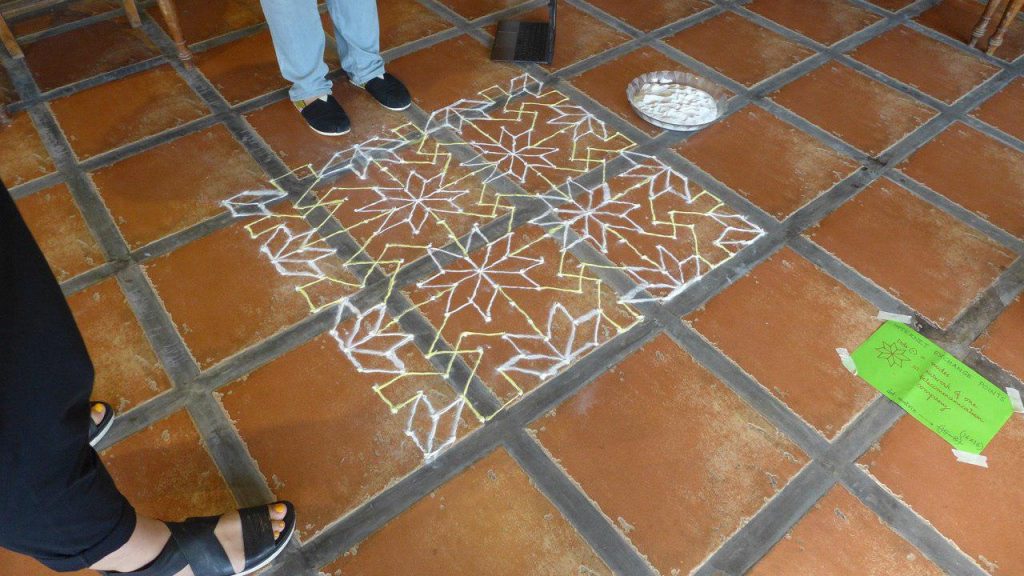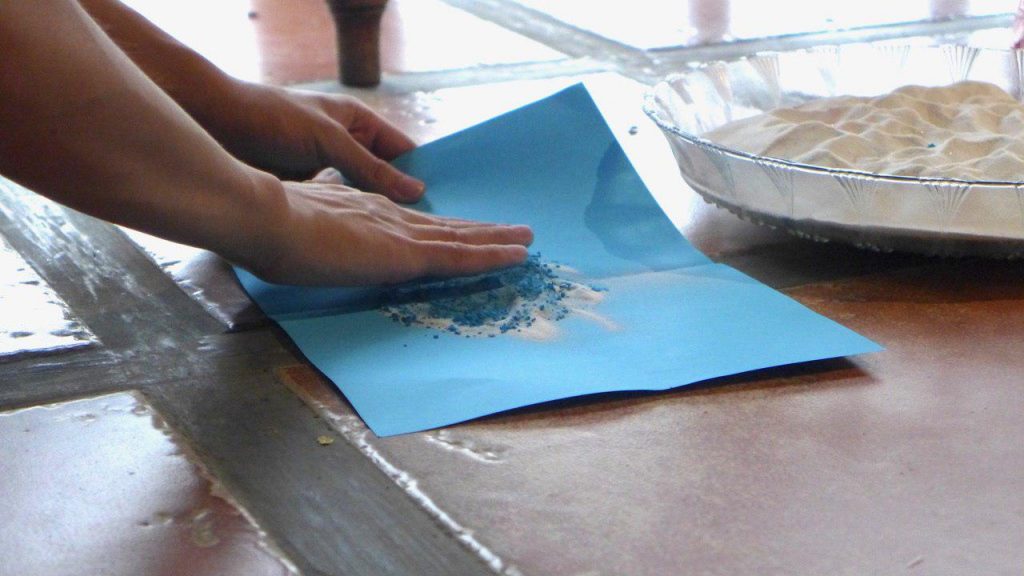Rangoli as a way to explore networks
by Nayantara Ranganathan
“Break it down.”
“Lose the jargon.”
“No, you may not borrow any more salt and pepper shakers and move them around!”
Sound familiar?

Participants at COCONET digital rights camp, reproducing a rangoli design drawn on paper, which was a representation of local area networks (LAN) and wide area networks (WAN). Photo by @nicadoom.
As digital rights advocates and activists, there are many occasions where we discuss networks — how the internet works, who are the entities involved in the delivery of a message, what’s the problem with Facebook etc., — to an audience that can be anything from plain disinterested to positively threatened by the unfamiliarity of the details.
Insecurity around technical concepts #
Insecurity around technical concepts can be because people don’t see themselves as natural possessors or purveyors of such information: for lack of formal training, for reasons of belonging to a group which is conditioned to not think of themselves as at ease around technical concepts, whatnot.
Using devices people are familiar with, to talk about concepts they are unfamiliar with, is a learning theory that is commonly used. With this in mind, rangoli could be a potent way to talk about networks and the internet to persons familiar with rangoli, but not necessarily experts on networks.
Given that putting(?) or drawing rangoli is something that has traditionally been the job of women and girls, and given that rangoli lends itself to improvisation and new designs, it seemed useful as a tool to dislodge discomfort around technical concepts. This is not to essentialise all women and girls as engaged in drawing rangoli, or to generalise all women as being afraid of technical concepts.
I decided to try using rangoli to talk about networks at COCONET, a South East Asia digital rights camp held in October 2017.
What we did #
This was an experiment on two levels: first, because I hadn’t tried this properly before, and second, because the participants would not actually be familiar with rangoli — thereby potentially defeating the point of the exercise!
After having many helpful conversations with friends* at the camp, I settled on three levels of doing this:
First, we began with a few rangoli designs already drawn, with the aim of discussing simple and specific concepts. The two pre-drawn designs were supposed to be simplified representations of (1) the internet as a network of networks and (2) interconnections and internet exchange points.

Rangoli to explain Internet Exchange Points. Photo by Juana Jaafar
Second, we used prompts of designs already drawn on sheets of paper, and reproduced them using rangoli powder, so that everyone could get their hands dirty and get used to drawing with the powder. We got midway through drawing a design representing local area networks and wide area networks.
Third, we would pick from a pre-decided set of options, where concepts like ‘protocols’, ‘proxies and Virtual Private Networks’ etc., were written down on paper, with a simple explanation of what it means. Participants drew these concepts in small groups, not necessarily in rangoli patterns.
The discussions went beyond what was planned, and covered many more concepts than I had hoped for. We represented gated communities and problems with centralisation on platforms like Facebook, looked at how TOR provides anonymity, discussed different network topographies and levels of competition in the telecom sectors of different countries, among other things.
Thoughts from the experiment #
- Such a workshop is a good way to do ‘learning together’ as opposed to one person lecturing others (although at COCONET, there was a fair amount of ‘teaching’ — not the networks part, but how to draw with rangoli powder.) A good mix of participants for such a workshop would be people who are familiar with rangoli, but not networking concepts + people who are familiar with networking concepts, but not rangoli — so that ‘expertise’ is distributed, and there’s room for learning one of the two things for all attending.

Photo by Juana Jaafar
-
The exercise works to an extent even with persons not familiar with rangoli. The act of making something aesthetically appealing, with your hands, is immersive and can engage even those people not familiar with the medium.
-
At the Internet Democracy Project, we do workshops with activists working on women’s rights, LGBTQ rights etc. and use methods and resources developed by colleagues across the world. While these are super helpful, we find there are not nearly enough locally oriented methods, in local languages that are ready for use. Increasingly, either for public mobilisation for issues like network neutrality or for advocating for the relevance of digital rights in other activisms, there remains a stark gap in getting the message across, and in a way that is not tedious. We hope to develop and integrate such methods in the work that we do. (This is work-in-progress, so stay tuned!)
–
If you’re interested in doing this together sometime, please feel free to get in touch at email hidden; JavaScript is required .
*(Thanks to Cathy, Cheekay, Adam, Juana, Asher, Srinidhi, Serene for helping me think through the process, and to Cathy and Srinidhi for helping make the rangoli in time! ❤)